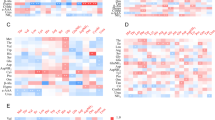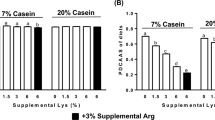Abstract
l-Tryptophan (Trp) and some of its metabolites regulate the circadian rhythm in mammals. We aimed to investigate the effects of short-term supplementation of Trp in isocaloric meals on growth performance using the parameters of multiple blood biomarkers and free amino acids in growing pigs. A total of 32 Landrace × Yorkshire barrows with a mean body weight of 8.64 (±1.13) kg were randomly assigned to four groups and then fed with various concentrations of Trp diets daily. Our results showed that sequential supplementation of different concentrations of Trp in isocaloric meals decreased the feed:gain (F:G) ratio (P = 0.079) and plasma urea and albumin (P = 0.019), whereas the level of total protein did not. Among the essential and conditionally essential amino acids, the concentrations of histidine, isoleucine, proline, threonine, arginine, and valine in the plasma decreased (P < 0.05), whereas the concentrations of Trp, glycine, serine, and methionine increased (P < 0.01). In addition, concentrations of branched chain amino acids also significantly decreased (P = 0.004), while the rate of conversion of Trp to branched chain amino acids increased (P < 0.001). Taken together, we show that administration of a high concentration of Trp in breakfast with decreasing concentrations of Trp in lunch and dinner positively affected feed utilization and improved feed efficiency, at least in part, through the optimization of amino acid interconversions and nitrogen utilization.

Similar content being viewed by others
References
Arendt J (2011) The pineal gland and pineal tumours. In: De Groot LJ, Chrousos G, Dungan K et al (eds) Endotext [Internet]. MDText.com, Inc., South Dartmouth, MA. https://www.ncbi.nlm.nih.gov/books/NBK279108/
Brown J, Cline T (1974) Urea excretion in the pig: an indicator of protein quality and amino acid requirements. J Nutr 104(5):542–545
Cortamira N, Seve B, Lebreton Y, Ganier P (1991) Effect of dietary tryptophan on muscle, liver and whole-body protein synthesis in weaned piglets: relationship to plasma insulin. Br J Nutr 66(03):423–435
Cubero J, Valero V, Sánchez J, Rivero M, Parvez H, Rodríguez A, Barriga C (2005) The circadian rhythm of tryptophan in breast milk affects the rhythms of 6-sulfatoxymelatonin and sleep in newborn. Neuroendocrinol Lett 26(6):657–662
Demain A, Annu RO, Plaut G, Smith C, Alworth W, der Riboflavinbiosynthese Z (1972) Tryptophan entry into the brain: modifications in response to food ingestion and albumin binding. Rev Microbiol 26:369–388
Eder K, Peganova S, Kluge H (2001) Studies on the tryptophan requirement of piglets. Arch Tierernahr 55(4):281
Fang J, Yan F, Kong X, Ruan Z, Liu Z, Huang R, Li T, Geng M, Yang F, Zhang Y (2009) Dietary supplementation with Acanthopanax senticosus extract enhances gut health in weanling piglets. Livestock Sci 123(2):268–275
Ha C, Bhagavan N (2013) Novel insights into the pleiotropic effects of human serum albumin in health and disease. Biochem Biophys Acta 1830(12):5486
Harada T, Nakade M, Wada K, Akimitsu O, Noji T, Krejci M, Takeuchi H (2013) Tryptophan and sleep: breakfast tryptophan content and sleep. In: Preedy VR, Patel VB, Le L-A (eds) Handbook of nutrition, diet and sleep. Wageningen Academic Publishers, Wageningen, pp 472–487. doi:10.3920/978-90-8686-763-9_33
Heine WE (1999) The significance of tryptophan in infant nutrition. In: Huether G, Kochen W, Simat TJ, Steinhart H (eds) Tryptophan, serotonin, and melatonin: basic aspects and applications. Springer US, Boston, MA, pp 705–710. doi:10.1007/978-1-4615-4709-9_91
Klonoff-Cohen H, Barrett-Connor EL, Edelstein SL (1992) Albumin levels as a predictor of mortality in the healthy elderly. J Clin Epidemiol 45(3):207–212
Kragh-Hansen U (1981) Molecular aspects of ligand binding to serum albumin. Pharmacol Rev 33(1):17
Moehn S, Pencharz PB, Ball RO (2012) Lessons learned regarding symptoms of tryptophan deficiency and excess from animal requirement studies. J Nutr 142(12):2231S–2235S. doi:10.3945/jn.112.159061
Naatjes M, Htoo J, Walter K, Tölle K, Susenbeth A (2014) Effect of dietary tryptophan to lysine ratio on growth of young pigs fed wheat–barley or corn based diets. Livestock Sci 163:102–109
NRC (2012) Nutrient requirements of swine, 12th edn. Natl. Acad. Press, Washington, DC
Pascucci T, Andolina D, La Mela I, Conversi D, Latagliata C, Ventura R, Puglisi-Allegra S, Cabib S (2009) 5-Hydroxytryptophan rescues serotonin response to stress in prefrontal cortex of hyperphenylalaninaemic mice. Int J Neuropsychopharmacol 12(8):1067–1079
Shibuya H, Toru M, Watanabe S (1977) A circadian rhythm of tryptophan hydroxylase in rat pineals. Brain Res 138(2):364–368
Silber B, Schmitt J (2010) Effects of tryptophan loading on human cognition, mood, and sleep. Neurosci Biobehav Rev 34(3):387–407
Sodhi MS, Sanders-Bush E (2004) Serotonin and brain development. Int Rev Neurobiol 59:111–174
Susenbeth A (2006) Optimum tryptophan: lysine ratio in diets for growing pigs: analysis of literature data. Livestock Sci 101(1):32–45
Tossou MCB, Liu H, Bai M, Chen S, Cai Y, Duraipandiyan V, Liu H, Adebowale TO, Al-Dhabi NA, Long L, Tarique H, Oso AO, Liu G, Yin Y (2016) Effect of high dietary tryptophan on intestinal morphology and tight junction protein of weaned pig. BioMed Res Int 2016:2912418. doi:10.1155/2016/2912418
Xie C, Wu X, Li J, Fan Z, Long C, Liu H, Even PC, Blachier F, Yin Y (2015) Effects of the sequence of isocaloric meals with different protein contents on plasma biochemical indexes in pigs. PLoS ONE 10(8):e0125640
Yin Y, Huang R, Li T, Ruan Z, Xie M, Deng Z, Hou Y, Wu G (2010) Amino acid metabolism in the portal-drained viscera of young pigs: effects of dietary supplementation with chitosan and pea hull. Amino Acids 39(5):1581–1587
Yin J, Ren W, Duan J, Wu L, Chen S, Li T, Yin Y, Wu G (2014) Dietary arginine supplementation enhances intestinal expression of SLC7A7 and SLC7A1 and ameliorates growth depression in mycotoxin-challenged pigs. Amino Acids 46(4):883–892
Yin J, Duan J, Cui Z, Ren W, Li T, Yin Y (2015) Hydrogen peroxide-induced oxidative stress activates NF-κB and Nrf2/Keap1 signals and triggers autophagy in piglets. RSC Adv 5(20):15479–15486
Author information
Authors and Affiliations
Contributions
HL designed the study, analyzed data, and drafted the manuscript with CAH. MB and MCT conducted the research. KX and FL participated in the experimental design and statistical analysis. XK provided essential materials. XW and YY participated in the experimental design and helped draft the manuscript. Additionally, HL had final responsibility for content while all authors read and approved the final manuscript.
Corresponding authors
Ethics declarations
Ethical standards
The protocol for this study was approved by the Committee on the Ethics of Animal Experiments of the Institute of Subtropical Agriculture, Chinese Academy of Sciences (Permit Number: 201506-11), and it was conducted out in accordance with the recommendations in the Guide for the Care and Use of Laboratory Animals of the Institute of Subtropical Agriculture, Chinese Academy of Sciences.
Funding
We would like to express our sincere gratitude to the research program of the National Natural Science Foundation of China (31501964; 31601953; 31402088), Chinese Academy of Sciences visiting professorship for senior international scientists (2016VBB007), the State Key Laboratory of Food Science and Technology, Nanchang University (Project No. SKLF-ZZB-201509), and the Key Research and Development Program of Shandong Province (2015STS007), which allowed the research to be completed. We also thank Hangzhou King Techina Technology Company Academician Expert Workstation and Shandong Newhope-Liuhe Group Company Academician Expert Work station for providing technical assistance.
Conflict of interest
The authors declare that they have no conflict of interest.
Additional information
Handling Editors: C.-A. A. Hu, Y. Yin, Y. Hou, G. Wu, Y. Teng.
Rights and permissions
About this article
Cite this article
Liu, H.N., Hu, CA.A., Bai, M.M. et al. Short-term supplementation of isocaloric meals with l-tryptophan affects pig growth. Amino Acids 49, 2009–2014 (2017). https://doi.org/10.1007/s00726-017-2440-3
Received:
Accepted:
Published:
Issue Date:
DOI: https://doi.org/10.1007/s00726-017-2440-3




